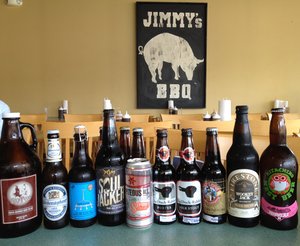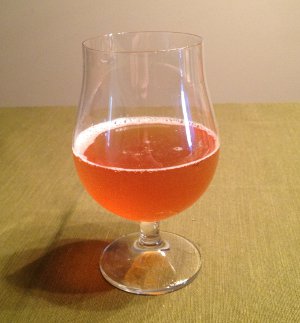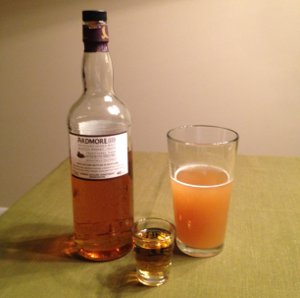Homebrewing has been a real blast. I mean, I'm not a miracle worker, but I have managed, on several occasions, to turn water into beer. How awesome is that? Even when the results don't come out as planned, it's a fun hobby. I reviewed my first batch of homebrew, a brown ale, before I started my second beer (around a year ago), but for a variety of reasons (i.e. laziness), I've since fallen way behind on reviewing my beers. So over the course of this past week, I've cracked open one of each unreviewed homebrew and gave it a whirl. I suppose I should note the obvious conflict of interest here. While I'm sure you all think of me as a BJCP approved expert and grandmaster Cicerone, my beer tasting notes are highly subjective on even the best day, so my notes on beers I've brewed myself might be overly harsh or too lenient. I really don't know which, and maybe both are present in my notes. Make of this what you will, but since I bore you all to tears with my tedious brewing-day recaps, I figured it'd be worth letting you know how they came out (at least, in my mind and in the probably-no-definitely biased feedback from friends and family).
Homebrew #2: Trappist Tripel - I went a little adventurous for my second brew. High gravity beers are more difficult to brew for a variety of reasons, but I did alright, despite a few rookie mistakes. There are some good things about it, but it ended up with a lot of alcohol character in the taste. It has gotten better with age though, and I think I may be experiencing "waves of maturation", as sometimes I think this has turned out reasonably well, and other times I think it's kinda horrible. I still have about a half a case of this left, and with such a high ABV, I think I'll let it continue to mature (checking on it occasionally). Feedback from friends and family indicates that the beer is rather heavy, which it is... Let's see how this one treats me:

Pours a clearish golden color with a little orange and a finger of head. The smell is quite nice. Typical bready Belgian yeast and spice, along with a surprising fruity character and a not-so-surprising boozy factor. Taste is sweet with that Belgian spice character and plenty of booze, which really asserts itself in the finish and aftertaste. The mouthfeel is full bodied with solid carbonation to start and a little bit of a sticky finish (which becomes more pronounced as the beer warms up). Plenty of warming alcohol character... actually a bit too much hotness here, which is this beer's one major flaw. Overall, it's actually gotten better with age, though I wouldn't call it great. Not bad for my sophomore effort though! B
Beer Nerd Details: 10% ABV bottled (12 oz.) Drank out of a goblet on 3/13/12. Bottled on 3/6/11.
Homebrew #3: Bavarian Hefeweizen - This is, without a doubt, the worst beer I've ever made. I'm not sure what went wrong here, but there's always been a very distinct off flavor here that I can't quite describe. I want to say it's vegetative, but that's not really right. None of the traditional off flavors seem to describe what I'm getting out of the taste of this beer. In any case, at no point has it ever resembled an actual wheat beer, aside from perhaps the yeast character (which shares a lot with Belgian yeasts). Let's see how it's doing now:
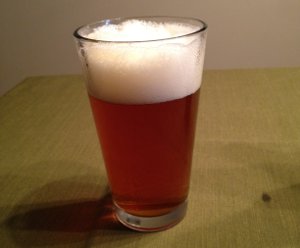
The beer looks pretty enough. Perhaps a little dark for the style, but a nice golden orangeish color with tons of head. When the beer was young, the aromas were dominated by banana, but as time has gone on, the clove has come out more. It actually smells pretty darn good. The taste is better now than it was when it was young, but there are some off flavors present and it still doesn't taste at all like wheat. There's an almost tinny undertone to the beer as well. Carbonation is very high and along with the spice, it's got a bit of a harsh mouthfeel (this isn't normally a bad thing in my book, but for this particular beer it is). Overall, it's not a complete abomination and it's actually drinkable, but there is something wrong with it. (Other folks have told me that they don't mind this beer, so maybe I'm being to hard on myself, but in honesty, this beer turned out nothing like what I was going for, and so thus I rate it lowly!) D
Beer Nerd Details: 5.25% ABV bottled (12 oz.) Drank out of a shaker pint on 3/10/12. Bottled 5/15/11.
Homebrew #4: Saison - This was the first homebrew I made that I truly loved. I patterned the recipe after Saison Dupont (one of my favorites) and the beer actually turned out that way, so this all makes sense. I was very excited about this batch and impatiently cracked one open after only one week of bottle conditioning. And it was perfect. Beautiful fragrant spices and pale malts, very deep flavors, perfect carbonation and a well balanced, full body. Unfortunately, that perfection hasn't lasted. The beer is still good, but I perhaps used too much priming sugar, as bottles these days tend to be overcarbonated and as the beer has matured, it's taken on a bit of that boozy hotness (nowhere near the levels of the tripel, but still there). I think I underestimated how effectively the 3711 French Saison yeast would eat up the wort, as this did come out a bit stronger than I was looking for. If I make something like this again, it will be a little lower in gravity, with less priming sugar at bottling time, and again, I think better temperature control will also be helpful. Anyways, response to this beer has been generally positive, though some don't like the spicy and overcarbonated nature of the beer. Here we go:
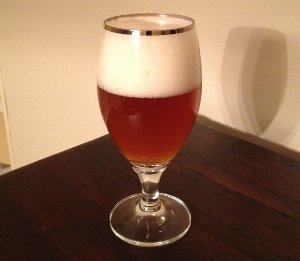
Pours a cloudy golden yellowish color with tons of fluffy head that leaves a little lacing as I drink. Smell is filled with spicy aromas (definitely clove, maybe some banana and bready Belgian yeast. The taste is sweet, but filled with spiciness (again clove), and a mild bitterness in the very dry finish (this level of bitterness wasn't in the beer on the first week, but it's not inappropriate either). Maybe just a hint of booze as well. Mouthfeel is very strong, full bodied, and harsh with tons of carbonation. Overall, it's still quite good, but it's not even really close to my initial taste of the stuff. B+ (though maybe an A for that first taste).
Beer Nerd Details: 7.5% ABV bottled (12 oz.) Drank out of a goblet on 3/10/12. Bottled on 7/6/11.
Homebrew #5: Stout - The goal with this one was to make a stout with more than a one dimensional roasty character to it. I planned to emphasize chocolate and caramel in this batch, and for the most part I succeeded. However, the beer does have some issues. No real "defects" per say, just things that aren't ideal. For instance, the final gravity was around 1.020, which makes for quite a heavy tasting beer - I was hoping for more attenuation here. Perhaps as a result, the head on this beer is pretty lackluster, and it fades quickly. Its the sort of beer that starts off well, but gets to be a bit much by the end of the bottle. Perhaps it will improve with time, but here's what I'm getting out of it now:
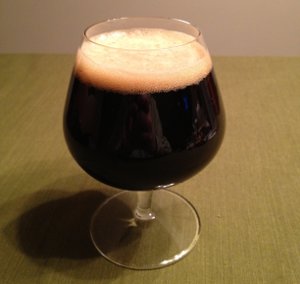
Pours a very dark brown color, almost black (no highlights when held up to light) with a finger of quickly disappearing light brown head. The smell features that caramel malt in full force, with a chalky roastiness also present, maybe just a hint of coffee. The taste is similar, though the roasted malts are more prominent here and it could perhaps have used a bit more hop balance. Still, it's not one dimensionally roasty, and that caramel and chocolate malt adds a nice complexity to the taste. The mouthfeel is extremely heavy and full bodied. It's well carbonated, but a little acidic in the finish, especially as it warms up. It's the sort of beer that starts out well enough, but it really gets rough towards the end of the glass. Overall, it's ok, in the direction I wanted to go, but it hasn't quite reached the destination. I think some recipe tweaks, either toning it down (or up!) and using some more hops could help it out. I also need to figure out how to get a little more attenuation out of the yeast... Again, I like this beer, it's really interesting, but it's hard to rate it very high when even I can't seem to finish an entire bottle of it. C+ (would be maybe a B- or B if it held itself together longer)
Beer Nerd Details: 5.5% ABV bottled (12 oz.) Drank out of a snifter on 3/11/12. Bottled on 8/28/12.
Homebrew #6: Spiced Christmas Ale - Not to toot my own horn, but this is the best beer I've made so far (ok, I'm going to toot my own horn a little ). It's a winter warmer style beer whose recipe was created on-the-fly in the homebrew shop (with a lot of help from the owner). Anchor Christmas was something of an inspiration, but this beer isn't patterned after a specific version and I came up with the spicing regimen entirely on my own. It's the beer I'm most proud of, from the recipe and spicing regimen to the way it turned out. Seems to be a popular beer when I give it to others, including the guy at the homebrew shop (I totally owed him a couple bottles thanks to his improvisation), who asked if I entered it into any competitions. It turned out to be pretty much exactly what I wanted, and unlike the saison, it's stayed that way for a few months now. Ok, let's toot some more horns:
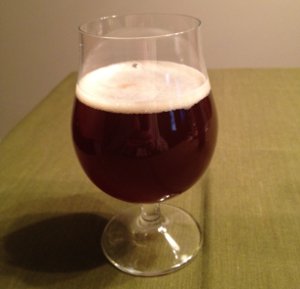
Pours a deep, dark amber color (almost, but not quite brown), with a finger of light colored head. Smells fantastic. The cinnamon and clove come through especially well, though I also get a fair amount of sugary citrus in the nose. A friend described it like it was a snickerdoodle cookie, which is pretty awesome. The taste has a sweetness to it, but it's very spicy and it has a well balanced, somewhat dry finish. The mouthfeel is a dream - smooth, almost creamy, medium bodied, a little harshness from the spiciness, but still quite quaffable (probably my most quaffable beer). Overall, I can't believe this beer came out as great as it did. I was worried that I'd overdo the spices (and in a lot of spiced winter beers, the spices are overpowering), but the spices I added balanced out really well. Again, this is probably my best beer, and I think it stacks up well against a lot of the commercial winter warmers I had this year. A-
Beer Nerd Details: 6.0% ABV bottled (12 oz.) Drank out of a tulip on 3/11/12. Bottled on 11/20/11.
Homebrew #7: Simcoe IPA - My most recent brew, it's only been 3 weeks since bottling. I've had a few of these so far (again, I was very impatient with this one) and damn it's been good. A little undercarbonated in the first week, but that should have worked itself out by now, so I'm really excited to try this out...

Pours a very pretty golden color with a finger of head that leaves a little lacing as I drink. Smells strongly of grapefruit and pine (interestingly, more pine now than in week 1) along with a nice sugary sweet aroma. The taste also starts off sweet, plenty of that citrus and pine hop character, and a nice, bracing bitterness in the relatively dry finish. Mouthfeel is quite good. Medium bodied and the carbonation has come up to speed too. Not sure how to describe it, but it's like the carbonation has small bubbles. Actually quite quaffable. Overall, this is one damn good IPA. There's nothing quite like a super-fresh IPA, but I can't wait to see how it matures over time as well. B+
Beer Nerd Details: 7% ABV bottled (12 oz.) Drank out of a snifter on 3/10/12. Bottled on 2/18/12.
So there you have it. All in all, I think I've got 3.5-4 cases of homebrewed beer left, with another 5 gallons (about 2 cases) in the fermenter right now. Alas, my best beers are the ones that go the fastest, and the IPA was a small batch to start with. Anyways, I've learned a lot since my first batch, and I think my past couple batches show that I've at least got the basics down. I'd list out some of those learnings, but that's perhaps another post for another day.

